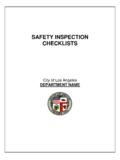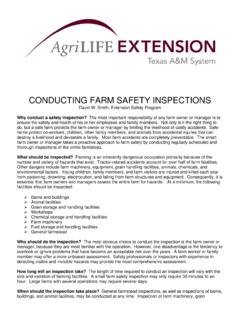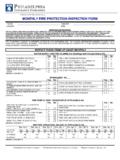Transcription of Anatomic Pathology Checklist
1 MasterEvery patientdeserves theGOLD STANDARD .. Anatomic PathologyChecklistCAP Accreditation ProgramCollege of American Pathologists325 Waukegan RoadNorthfield, IL and Copyright NoticeOn-site inspections are performed with the edition of the Checklists mailed to a facility at the completionof the application or reapplication process, not necessarily those currently posted on the Web site. Thechecklists undergo regular revision and a new edition may be published after the inspection materials questions about the use of the Checklists or Checklist interpretation, email or call800-323-4040 or 847-832-7000 (international customers, use country code 001).The Checklists used for inspection by the College of American Pathologists' Accreditation Programs havebeen created by the CAP and are copyrighted works of the CAP. The CAP has authorized copying anduse of the checklists by CAP inspectors in conducting laboratory inspections for the Commission onLaboratory Accreditation and by laboratories that are preparing for such inspections.
2 Except as permittedby section 107 of the Copyright Act, 17 sec. 107, any other use of the Checklists constitutesinfringement of the CAP's copyrights in the Checklists. The CAP will take appropriate legal action to protectthese Checklists are 2014. College of American Pathologists. All rights of Pathology ChecklistAnatomic PathologyChecklistTABLE OF CONTENTSSUMMARY OF Anatomic SPECIMEN CONSULTATION (RAPID DIAGNOSIS)..16 FINE NEEDLE ASPIRATE (FNA) Pathology QUALITY STAINS (HISTOCHEMISTRY)..27 IMMUNOLOGIC AND MOLECULAR AND NON-FLUORESCENCE IN SITU HYBRIDIZATION (FISH, ISH)..34 PREDICTIVE IMAGE and AND AND LABORATORY TUMOR CELL ANALYSIS (CTC)..53 VALIDATION AND CONTROL (CTC)..54 SPECIMEN (CTC)..57 PERSONNEL (CTC)..57 AUTOPSY CONSENT PERFORMANCE AND of Pathology ChecklistQUALITY MICROSCOPY SAMPLE AND , FILES AND of Pathology ChecklistON-LINE Checklist AVAILABILITYP articipants of the CAP accreditation programs may download the checklists from the CAP Web site ( )by logging into e-LAB Solutions.
3 They are available in different Checklist types and formatting options, including: Master contains ALL of the requirements and instructions available in PDF, Word/XML or Excel formats Custom customized based on the laboratory's activity (test) menu; available in PDF, Word/XML or Excelformats Changes Only contains only those requirements with significant changes since the previous checklistedition in a track changes format to show the differences; in PDF version only. Requirements that havebeen moved or merged appear in a table at the end of the OF Checklist EDITION CHANGESA natomic Pathology Checklist04/21/2014 EditionThe information below includes a listing of Checklist requirements with significant changes in the current editionand previous edition of this list is separated into three : Modifications that may require a change in policy, procedure, or process for continued compliance.
4 Or A change to the : Deleted Moved Relocation of a requirement into a different Checklist (requirements that have beenresequenced within the same Checklist are not listed) Merged The combining of similar requirementsNOTE:The listing of requirements below is from the Master version of the customized checklistversion created for on-site inspections and self-evaluations may not list all of these Checklist RequirementsEffective DateRequirement04/21 of Pathology Checklist04/21 Checklist RequirementsEffective DateRequirement07/29 Checklist RequirementsEffective DateRequirement04/20 of Pathology ChecklistINTRODUCTIONThis Checklist is used in conjunction with the All Common (COM) and Laboratory general Checklists to inspect ananatomic Pathology laboratory section or that do not file slides on-site ( "read-only" laboratories)
5 Must retain a sample of slides on-site forreview by the inspector on all days when the laboratory is subject to its regular on-site samplemust, at a minimum, include all slides accessioned over a continuous 2-week period within the previous 2 for non-US laboratories: Checklist requirements apply to all laboratories unless a specific disclaimer ofexclusion is stated in the Anatomic PATHOLOGYDo NOT use this Checklist if the laboratory does NOT perform any on-site preparation or examination of anatomicpathology specimens, but refers all submitted material to an outside laboratory, or if the laboratory's involvementin Anatomic Pathology is limited to filing of reports and/or slidesThis Checklist covers several areas of Anatomic Pathology services, and is divided into the following sections:Surgical Pathology , Histology Laboratory, Autopsy Pathology , and Electron Microscopy.
6 Cytopathology (bothgynecologic and non-gynecologic) is covered in a separate sequence for inspection of the anatomicpathology service is at the discretion of the inspection sequence herein is consistent with that used forall other sections of the laboratory, but is not Instructions: Sampling of formaldehyde/xylene vapor monitoring records**REVISED** 07/29/2013 Phase IIFormaldehyde/Xylene and xylene vapor concentrations are maintained below the following maxima,expressed as parts per million, in all areas of the Anatomic Pathology Department whereformaldehyde or xylene are : Formaldehyde and xylene vapor concentrations must be monitored in all areas where thesereagents are used: surgical Pathology gross dissection room, frozen section area, histologylaboratory, autopsy room, etc. Xylene vapor concentration monitoring in histology laboratoriesshould include manual and automated coverslipping areas, as these locations are often not monitoring involves identifying all employees who may be exposed at or above the actionlevel or at or above the STEL and accurately determining the exposure of each employee formaldehyde monitoring is mandated at least every 6 months if results of the initial monitoring7 of Pathology Checklistequal or exceed ppm (8 hr time-weighted exposure, the action level ) or at least once per yearif the results exceed the short term exposure limit (STEL) laboratory may discontinueperiodic formaldehyde monitoring if results from 2 consecutive sampling periods taken at least 7days apart show that employee exposure is below the action level and the short-term exposurelimit, and 1)
7 No change has occurred in production, equipment, process or personnel or controlmeasures that may result in new or additional exposure to formaldehyde, and 2) there have beenno reports of conditions that may be associated with formaldehyde monitoring must be repeated any time there is a change in production, equipment,process, personnel, or control measures which may result in new or additional exposure toformaldehyde for any employee involved in the activity. If any personnel report signs or symptomsof respiratory or dermal conditions associated with formaldehyde exposure, the laboratory mustpromptly monitor the affected person's must be monitored initially, but there is no requirement for periodic monitoring of monitoring should be considered when there is a change in production, equipment, process,personnel, or control measures likely to increase exposure min Short-TermAverage Exposure Limit(STEL)Action Level ( 8 hrTime-WeightedExposure)8 hr Time-Weighted of Compliance.
8 Written procedure for formalin/xylene safety including action limits, criteria for discontinuationof monitoring and criteria for resumption of monitoring AND Record of initial formalin/xylene monitoring and repeat monitoring when indicated AND Records of corrective action when exposure limits are exceededREFERENCES1) Montanaro A. Formaldehyde in the workplace and in the home. Exploring its clinical Med. 1996;27:752-7572) Goris JA. Minimizing the toxic effects of Med. 1997;29:39-423) Wenk PA. Disposal of histology Med. 1998;29:337-3384) Occupational Safety and Health Administration. and 1450, revised July 1, 1998 SURGICAL PATHOLOGYQUALITY MANAGEMENTMany technical and procedural quality control items are covered elsewhere in this are integralcomponents of comprehensive quality management and should be included within the defined determines if there is an active program of surveillance of the quality of surgical Pathology activities,particularly the diagnostic reports.
9 How this is accomplished depends upon the number of departmental staff, aswell as the volume and type of diagnostic material. Such a program must include appropriate combinations ofactivities such as the use of intra- and extra-departmental consultations, circulation of diagnostic material (randomor by case type), periodic review of completed surgical Pathology reports, and participation in self-assessment andperformance improvement of Pathology ChecklistInspector Instructions: Sampling of the following records: previous/current material review, intra-departmentalconsultations, extra-departmental consultations Does your laboratory exclude any specimen types from routine submission to thepathology department? What is your laboratory's course of action when a significant disparity exists betweenthe initial intra-operative consultation and final Pathology diagnosis?
10 Phase ISurgical Pathology is a policy that lists specimens that an institution may choose to exclude from routinesubmission to the Pathology department for :This policy should be made in conjunction with the hospital administration and appropriatemedical staff departments. The laboratory director should have participated in or been consultedby the medical staff in deciding which surgical specimens are to be sent to the Pathology departmentfor Checklist item is not applicable if 1) all specimens are submitted to Pathology , or 2) the laboratoryis not part of an institution that provides surgical ) Kassan MA, et al. Value of routine Pathology in herniorrhaphy performed upon adults. Surg Gynecol Obstet. 1986;163:518-5222) Netser JC, et al. Value-based Pathology : a cost-benefit analysis of the examination of routine and non-routine tonsil and J Clin Pathol.







